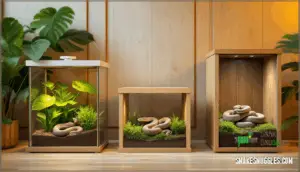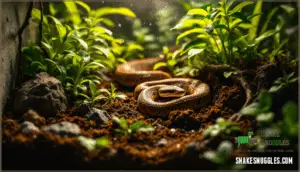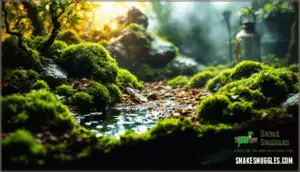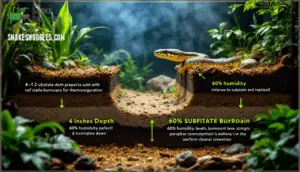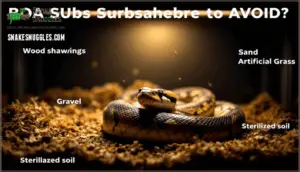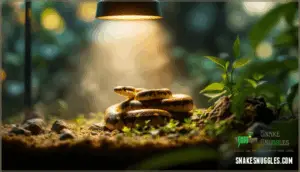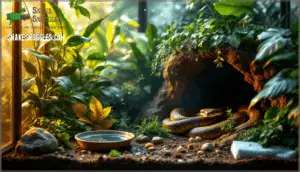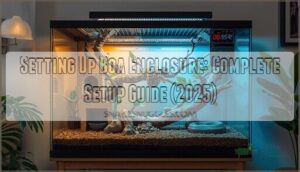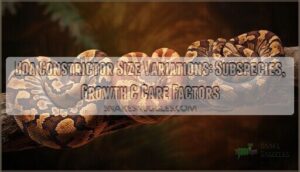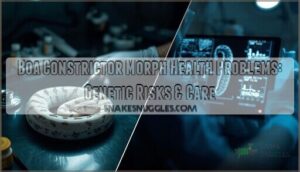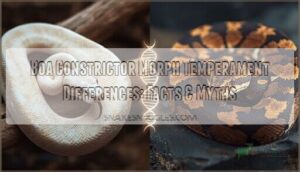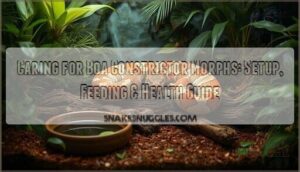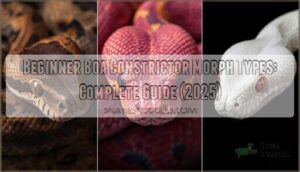This site is supported by our readers. We may earn a commission, at no cost to you, if you purchase through links.
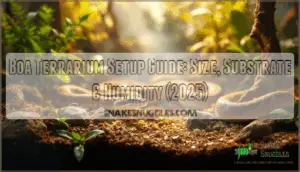
Your snake’s enclosure isn’t just a container; it’s a life-support system that directly influences thermoregulation, immune function, and behavioral health. Getting the setup right from the start prevents costly veterinary interventions and guarantees your boa thrives across its twenty-to-thirty-year lifespan, but the decisions you make about size, substrate, and humidity control require more precision than most generic care sheets suggest.
Table Of Contents
- Key Takeaways
- Choosing The Ideal Boa Terrarium Size
- Selecting The Best Enclosure Type
- Setting Up Bioactive Substrate Layers
- Optimizing Lighting and Temperature
- Maintaining Humidity and Cleanliness
- Frequently Asked Questions (FAQs)
- What size terrarium do boa constrictors need?
- How do I create a bioactive boa constrictor enclosure?
- What size enclosure does a boa constrictor need?
- Do boa constrictors need a vivarium?
- How do I heat and light a boa constrictor terrarium?
- How do you clean a boa constrictor terrarium?
- What enrichment items work best for boas?
- How often should I feed my boa?
- Can I house two boas together safely?
- What signs indicate my boa is stressed?
- Conclusion
Key Takeaways
- Boa constrictors require one square foot of floor space per foot of body length with vertical height equaling half their length, and most health problems stem from inadequate housing dimensions that fail to accommodate their rapid growth from juvenile to 6-10 foot adults.
- A properly layered bioactive substrate system using 4-12 inches of organic topsoil, Reptisoil, sphagnum moss, and leaf litter creates essential burrowing opportunities, maintains 60-70% humidity, and supports cleanup crew populations that eliminate manual waste removal.
- Precise environmental control through thermal gradients (75-80°F cool end, 90°F basking spot), 10-12 hour UVB photoperiods, and strategically placed thermostats prevents the respiratory infections, feeding refusal, and thermoregulation failures that plague improperly maintained enclosures.
- PVC enclosures retain heat 20% longer than glass and resist humidity-related warping, while front-opening doors eliminate predator-stress responses and proper ventilation maintains airflow without compromising the stable humidity zones critical for successful shedding.
Choosing The Ideal Boa Terrarium Size
Getting your boa’s terrarium size right isn’t just about giving them room to move—it’s about supporting their health, natural behaviors, and long-term growth. You’ll need to calculate the minimum floor space and vertical height based on your snake’s current and expected adult length.
Let’s break down how to measure your boa accurately, determine the ideal enclosure dimensions, and plan for their growth over time.
Measuring Boa Constrictor Length Accurately
You’ll need a flexible measuring tape and a steady hand to get an accurate read on your boa’s length—the foundation of proper enclosure sizing. Place your boa on a flat surface and gently extend its body from nose to tail tip, avoiding excess stretching that inflates measurements.
- Use a cloth or flexible measuring tape designed for curves and contours
- Measure your boa constrictor after feeding has digested to avoid defensive behavior
- Record length calculations monthly for juvenile boas experiencing rapid growth
- Double-check measurements by having a second person assist with positioning
- Document accurate sizing records to track enclosure size needs over time
Calculating Minimum Floor and Vertical Space
Once you’ve measured your boa’s total length, convert that number into square footage using the one-square-foot-per-foot-of-snake formula—a straightforward calculation that prevents the cramped conditions linked to respiratory infections and stress-related feeding refusal.
A four-foot boa requires four square feet of floor area, which translates to enclosure dimensions like 4×1 feet or 2×2 feet.
Don’t overlook vertical height—provide at least half your snake’s length in climbing space to support semi-arboreal behavior and thermoregulation.
Adapting Enclosure Size for Growth
Plan ahead for your boa’s rapid growth—juveniles can double in size within eighteen months—by investing in an appropriately sized adult enclosure from the start or budgeting for at least two housing upgrades during the first three years.
Recalculate minimum floor space and vertical height requirements as your snake grows, using updated snake length measurements every six months.
Upgrading too late restricts semiarboreal climbing behavior and compromises thermoregulation, while premature placement in oversized enclosures can trigger feeding refusal in nervous juveniles.
Selecting The Best Enclosure Type
You’ll need to choose the right type of enclosure before you can create the ideal environment for your boa. Glass, PVC, and wood enclosures each offer distinct advantages for temperature control, humidity retention, and long-term maintenance.
Let’s examine the three main options and how they compare for boa constrictor housing.
Glass Vs. PVC Vs. Wood Enclosures
Glass terrariums offer excellent visibility for monitoring your boa’s health, but they lose heat rapidly and show smudges easily, demanding frequent cleaning.
PVC enclosures retain heat up to 20% longer, resist warping in high humidity, and weigh 40–60% less than glass—making them ideal for long-term reptile habitat stability and easier relocation.
Wood provides good insulation but requires intensive waterproofing to prevent mold within 1–2 years in humid snake enclosure conditions.
When choosing materials, consider the humidity resistance factors to guarantee the best environment for your boa.
Front-Opening Doors and Ventilation
Front-opening doors eliminate the predator-swoop stress that top access triggers, while strategic ventilation panels prevent the dual threats of respiratory infection from stagnant air and dehydration from excessive drafts.
Position mesh vents on opposing walls to drive fresh air exchange without compromising humidity control—your boa constrictor needs airflow management that maintains 50–60% relative humidity while replacing stale air every 3–4 hours through properly sealed enclosure doors.
Juvenile Vs. Adult Boa Housing Needs
Juvenile boas thrive in cozy 20–40 gallon enclosures that prevent stress and feeding refusal, but you’ll need to scale up to a minimum 6-foot-long adult setup before your snake outgrows its space and develops behavioral problems.
Monitor your boa constrictor’s growth stages every 3–4 months—when the snake reaches two-thirds of the enclosure length, initiate a habitat shift to prevent territorial aggression and confirm adequate temperature gradients throughout its life cycle.
Setting Up Bioactive Substrate Layers
A bioactive substrate creates a natural foundation that sustains your boa’s health while mimicking its wild environment.
The layers you choose will determine drainage efficiency, moisture retention, and whether your snake can express natural burrowing behaviors.
Here’s what you need to build an effective substrate system that balances functionality with biological activity.
Benefits of Organic Topsoil and Reptisoil
Organic topsoil and Reptisoil form the foundation of a successful bioactive enclosure, supporting moisture management and nutrient cycling essential for reptile care.
Topsoil retains 28–44% water by volume, maintaining humidity around 60–70% in your terrarium with minimal misting. Reptisoil adds soil structure that prevents collapse during burrowing while controlling odors through microbial diversity.
This substrate blend fosters bioactive ecosystems where beneficial microbes and cleanup crews thrive, establishing proper microbe balance for long-term terrarium health. The choice of substrate, such as reptile soil mix, is vital for maintaining ideal humidity and moisture levels.
Using Sphagnum Moss and Leaf Litter
Sphagnum moss and leaf litter work like a humidity buffer and natural mulch layer, creating microclimates that support healthy shedding while feeding your cleanup crew. Place sphagnum moss in humid hides and around water bowls to maintain localized moisture zones without oversaturating your entire substrate.
Proper layering techniques:
- Mix leaf litter throughout the top 2 inches to encourage isopod reproduction and fungal colonization
- Refresh moss every 4–6 weeks to prevent bacterial overgrowth and maintain odor control
- Monitor substrate moisture with a hygrometer—aim for 60–70% humidity at the surface level
Achieving Proper Substrate Depth for Burrowing
Your boa needs 4 to 12 inches of substrate depth to express natural burrowing instincts and thermoregulate effectively—shallow layers force your snake to stay exposed, increasing stress and limiting behavioral enrichment.
Deeper bioactive enclosures allow stable burrow construction, especially when you layer topsoil with reptisoil for structural integrity.
Monitor soil moisture at different depths—aim for 60% humidity at 6 inches down to support both burrowing behavior and cleanup crew activity without compromising burrow stability in your boa constrictor terrarium.
Substrate Options to Avoid
Certain substrates create a minefield of health risks—from respiratory irritation to impaction—that can turn your carefully designed bioactive terrarium into a veterinary emergency waiting to happen. Wood shavings release aromatic phenols that damage respiratory epithelium, while sand risks intestinal obstruction during feeding strikes.
Some substrates—wood shavings, sand, gravel—turn bioactive terrariums into health hazards through respiratory damage, impaction, and bacterial growth
Gravel issues include ingestion hazards and sharp edges that traumatize ventral scales. Artificial grass harbors bacterial colonies between fibers despite cleaning attempts.
Sterilized soil lacks microbial activity essential for bioactive function, and substrates promoting excessive humidity retention increase scale rot incidence in your boa constrictor.
Optimizing Lighting and Temperature
Getting the lighting and temperature right isn’t just about comfort—it’s about creating the thermal regulation your boa needs to thrive. You’ll need to balance UVB exposure, establish proper heat gradients, and monitor conditions with precision.
Let’s break down each component so you can set up a system that fosters your snake’s health from day one.
UVB Lighting and Photoperiod Requirements
Proper UVB lighting isn’t optional—it directly facilitates vitamin D3 synthesis and calcium metabolism in your boa constrictor. You’ll need to provide a consistent photoperiod of 10-12 hours daily to maintain natural circadian rhythms and metabolic function.
Position your UVB bulb to create appropriate intensity gradients across the enclosure, allowing your boa to self-regulate exposure. This lighting cycle mimics seasonal patterns and prevents disruption to feeding, shedding, and overall physiological health.
Creating Temperature Gradients and Basking Spots
After establishing the right light exposure, you’ll need to engineer a thermal gradient of 75-80°F on the cool end and 90°F at the basking spot to support proper thermoregulation and metabolic function.
Your heat lamp placement determines whether your boa can effectively utilize this temperature gradient:
- Position heat sources at one end to create a measurable thermal gradient
- Use a dimming thermostat to prevent dangerous temperature spikes
- Verify basking area surface temperature reaches 90°F consistently
- Maintain the cool zone between 75-80°F for behavioral thermoregulation
- Monitor ambient air temperature throughout the enclosure daily
Thermometer and Thermostat Placement
Accurate measurement of thermal zones means nothing if your monitoring equipment sits in the wrong location—a misplaced thermometer can create a 10-15°F gap between what you’re reading and what your boa actually experiences.
Position digital thermometers with probes directly on substrate surfaces at both the basking zone and cool end, not on enclosure walls. Your thermostat sensor must contact the heat source’s target area to prevent overheating.
Verify readings across multiple climate zones daily for reliable temperature control.
Maintaining Humidity and Cleanliness
Maintaining stable humidity levels and keeping your boa’s enclosure clean aren’t just about aesthetics—they’re critical for preventing respiratory infections, guaranteeing successful sheds, and supporting long-term health.
You’ll need to balance moisture retention with proper ventilation while establishing a cleaning routine that doesn’t disrupt your snake’s environment.
Let’s break down the specific protocols for humidity management, water provision, sanitation practices, and bioactive system maintenance.
Ideal Humidity Levels and Misting Schedules
Maintaining ideal humidity control between 55–75% RH prevents dysecdysis and respiratory complications in your boa constrictor. During shedding periods, you can temporarily increase humidity to 75–85% by adjusting misting techniques or activating fogger systems.
- Morning misting mimics natural dew cycles and raises ambient moisture efficiently
- Hygrometer calibration weekly guarantees accurate readings across temperature gradients
- Humid hide design with sphagnum moss provides localized 80%+ RH zones
Position digital hygrometer probes mid-level for representative ambient conditions, and adjust misting frequency based on substrate moisture retention and seasonal climate variations.
Water Bowl Size and Placement
Your boa’s water bowl functions as both a hydration station and a humidity amplifier—selecting the correct dimensions and location directly impacts thermoregulation, shedding success, and pathogen control.
Choose a water container large enough for complete immersion, with water depth matching half your boa’s body diameter. Position the bowl on the cooler side of the terrarium to prevent excessive evaporation while maximizing humidity boost.
Verify stable placement on flat substrate areas with drainage systems underneath to prevent saturation and bacterial proliferation in soaking areas.
Enclosure Cleaning and Health Monitoring
Three minutes of daily observation can prevent weeks of treatment—routine enclosure sanitation and targeted health assessments safeguard your boa against respiratory infections, parasitic loads, and metabolic disorders before clinical symptoms emerge.
Remove fecal matter immediately and establish weekly cleaning schedules for water bowls and surface debris. Monitor substrate dampness to prevent mold while maintaining proper humidity.
Document health checks noting appetite changes, respiratory sounds, and shedding quality—early detection transforms terrarium maintenance into preventive reptile health care.
Bioactive Substrate Maintenance Tips
Cleanup crews of springtails and isopods work tirelessly beneath the surface, but sustaining a bioactive terrarium demands strategic intervention to prevent substrate compaction, nutrient depletion, and microbial imbalances that compromise your boa’s health.
Monitor substrate moisture weekly—fungal overgrowth signals excessive humidity, while dusty soil indicates inadequate misting schedules. Turn the top two inches of substrate monthly to prevent compaction that restricts microfauna activity.
Supplement cleanup crews quarterly to maintain microbial balance, guaranteeing your bioactive enclosure continues processing waste efficiently without manual substrate cleaning interventions.
Frequently Asked Questions (FAQs)
What size terrarium do boa constrictors need?
Boa constrictors need a terrarium with a minimum floor space of one square foot per foot of snake length.
For adults reaching 6-10 feet, you’ll need an enclosure at least 6 feet long by 2 feet wide and 2 feet tall.
How do I create a bioactive boa constrictor enclosure?
To create a bioactive boa constrictor enclosure, layer organic topsoil with reptisoil and play sand for substrate mixing, then introduce microfauna like isopods and springtails.
Allow enclosure cycling for four weeks before adding your boa, maintaining ecosystem balance through proper humidity and bioactive maintenance protocols.
What size enclosure does a boa constrictor need?
When sizing your boa’s home, think of it like buying shoes for a growing teenager—you need room now and space to grow.
Calculate one square foot of floor space per foot of snake length, with vertical height equaling half the boa’s length for climbing.
Do boa constrictors need a vivarium?
While not strictly mandatory, vivariums provide significant reptile welfare advantages over basic enclosures.
They enable precise humidity control and substrate layering—critical factors that directly impact your boa constrictor’s respiratory health and shedding success.
How do I heat and light a boa constrictor terrarium?
Heat sources and lighting cycles work together to create the right environment. Use a heat lamp with a dimming thermostat to establish temperature gradients—90°F basking spots and 75-80°F cool zones.
Add UVB lighting for 10-12 hours daily to support vitamin D3 synthesis and calcium absorption.
How do you clean a boa constrictor terrarium?
You’ll need proper cleaning supplies and a terrarium sanitizing routine.
Remove waste daily, spot-clean substrate, and perform deep enclosure disinfection monthly using reptile-safe solutions.
Monitor humidity during maintenance to prevent stress.
What enrichment items work best for boas?
Provide climbing branches secured at multiple heights and diameters to encourage natural movement patterns. Include multiple hide spots of varying sizes to reduce stress.
Environmental enrichment like textured surfaces, safe plants, and varied terrain promotes exploratory behaviors essential for your boa’s psychological health.
How often should I feed my boa?
Juvenile boas under one year need appropriately sized prey every 7-10 days. Adults over three years should eat every 14-21 days.
Prey size should match your boa’s widest body girth to support healthy snake growth without regurgitation risks.
Can I house two boas together safely?
Cohousing boa constrictors isn’t recommended from a veterinary perspective. Snake compatibility issues arise because boas are solitary by nature. Housing multiple individuals together increases stress, competition for resources, and risk of disease transmission or snake fighting, even without visible aggression.
What signs indicate my boa is stressed?
Like a coiled spring ready to release, stressed boas display telltale signs: refusing food, excessive hiding, rapid breathing, defensive striking, poor shedding quality, constant restlessness or weaving motions, and altered body language indicating environmental factors need immediate adjustment.
Conclusion
The margin between thriving and surviving often comes down to millimeters—substrate depth, temperature probe placement, or ventilation gap width. Every parameter you’ve calibrated—from bioactive layer composition to basking gradient precision—now functions as preventive medicine rather than reactive treatment.
Your boa terrarium setup guide decisions compound over years, either supporting sturdy immune function or creating subclinical stressors that erode health incrementally. Monitor your snake’s behavior as the primary feedback mechanism: consistent feeding, regular exploration, and clean sheds confirm your husbandry protocols are working exactly as intended.
- https://www.inaturalist.org/observations?taxon_id=32092
- https://flickr.com/search/?text=boa%20constrictor%20wild
- https://reptilesupply.com/collections/reptile-ground-plants
- https://www.reptifiles.com/red-tailed-boa-care/boa-species-subspecies/.)
- https://reptifiles.com/boa-constrictor-care/boa-constrictor-enclosure-size/

